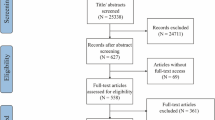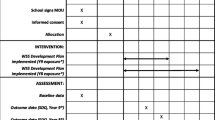Abstract
No single U.S. data source supports a multidimensional, population-based assessment of young children’s readiness to start school. This changed with the 2016 National Survey of Children’s Health (NSCH). This study provides an overview of the process by which content related to multiple domains of school readiness was identified, refined and selected for inclusion in the NSCH; describes the analytic processes and resultant outcomes associated with the development of domain-specific and summary measures of school readiness; and discusses opportunities to refine and validate these pilot measures to provide a national portrait of young children’s progress towards timely mastery of skills and competencies needed to be “Healthy and Ready to Learn.” The NSCH, an annual, address-based, self-administered survey, produces national- and state-level data on the physical and emotional health of children ages 0–17 years. In 2016, 22 items were added to assess school readiness among 3–5 year-olds and pilot summary measures of “Healthy and Ready to Learn” were developed. Four distinct domains were identified: Early Learning Skills, Self-Regulation, Social-Emotional Development, and Physical Health/Motor Development. Over four in ten children were “On Track” across all four domains while another three in ten were on track in three of the four domains. One in ten are reported to be “On Track” in ≤ 1 domain. New NSCH content and related summary measures of “Healthy and Ready to Learn” present a unique opportunity to extend what is known about young children’s school-readiness at both the national and state levels. Continued measure development and validation is required.


Similar content being viewed by others
References
American Psychological Association (2018). Effects of Poverty, Hunger and Homelessness on Children and Youth. http://www.apa.org/pi/families/poverty.aspx. Accessed 17 May 2018.
Bell, M. F., Bayliss, D. M., Glauert, R., & Ohan, J. L. (2018). School readiness of maltreated children: Associations of timing, type, and chronicity of maltreatment. Child Abuse & Neglect, 76, 426–439. https://doi.org/10.1016/j.chiabu.2017.12.001.
Bethell, C. (2008). Patient centered improvement of well-child care: Developing and evaluating the impact of patient-centered interventions to improve quality and equity of recommended services. .
Bethell, C., Newacheck, P., Hawes, E., & Halfon, N. (2014). Adverse childhood experiences: Assessing the impact on health and school engagement and the mitigating role of resilience. Health Aff (Millwood), 33(12), 2106–2115. https://doi.org/10.1377/hlthaff.2014.0914.
Blodgett, C., & Lanigan, J. D. (2018). The association between adverse childhood experience (ACE) and school success in elementary school children. School Psychology Quarterly, 33(1), 137–146. https://doi.org/10.1037/spq0000256.
Brooks-Gunn, J., & Markman, L. B. (2005). The contribution of parenting to ethnic and racial gaps in school readiness. The Future of Children, 15(1), 139–168.
Byrne, B. M. (2013). Structural equation modeling with Mplus: Basic concepts, applications, and programming. New York: Routledge.
Child Trends. (2001). School Readiness: Helping Communities Get Children Ready for School and Schools Ready for Children. https://www.childtrends.org/wp-content/uploads/2001/10/schoolreadiness.pdf. Accessed 5/31/18.
Child Trends. (2013). 5 things to know about school readiness. https://www.childtrends.org/child-trends-5/5-things-to-know-about-school-readiness/. Accessed 9/22/17.
Child Trends. (2015). Child Trends Databank: Early school readiness. https://www.childtrends.org/indicators/early-school-readiness/. Accessed 9/22/17.
Cohen, J., McCabe, E. M., Michelli, N. M., & Pickeral, T. (2009). School climate: Research, policy, practice, and teacher education. Teach Coll Rec, 111(1), 180–213.
Commonwealth of Australia. (2012). Australian Early Development Census. http://www.aedc.gov.au/. Accessed 22 Nov 2017.
Council on Early Childhood, & Council on School Health. (2016). The pediatrician's role in optimizing school readiness. Pediatrics, 138(3). https://doi.org/10.1542/peds.2016-2293.
Cunha, F., & Heckman, G. J. (2007). The economics of human development: The technology of skill formation. The American Economic Review, 97(2), 31–48.
Cunha, F., Heckman, J., & Schennach, S. (2010). Estimating the technology of cognitive and noncognitive skill formation. Econometrica, 78(3), 883–931. https://doi.org/10.3982/ECTA6551.
Eisenberg, N., Valiente, C., & Eggum, N. D. (2010). Self-regulation and school readiness. Early Education and Development, 21(5), 681–698. https://doi.org/10.1080/10409289.2010.497451.
Evans, G. W. (2004). The environment of childhood poverty. The American Psychologist, 59(2), 77–92. https://doi.org/10.1037/0003-066X.59.2.77.
Fantuzzo, J., Perry, M. A., & McDermott, P. (2004). Preschool approaches to learning and their relationship to other relevant classroom competencies for low-income children. School Psychology Quarterly, 19, 212–230.
Folger, A. T., Eismann, E. A., Stephenson, N. B., Shapiro, R. A., Macaluso, M., Brownrigg, M. E., et al. (2018). Parental adverse childhood experiences and offspring development at 2 years of age. Pediatrics, 141(4), https://doi.org/10.1542/peds.2017-2826, e20172826.
Ghandour, R., Jones, J., Lebrun-Harris, L., Minnaert, J., Blumberg, S., Fields, J., et al. (2018). The design and implementation of the 2016 National Survey of Children’s Health. Maternal and Child Health Journal. https://doi.org/10.1007/s10995-018-2526-x.
Hair, E., Halle, T., Terry-Humen, E., Lavelle, B., & Calkins, J. (2006). Children's school readiness in the ECLS-K: Predictions to academic, health, and social outcomes in first grade. Early Child Research Quarterly, 21(4), 431–454.
Health Resources and Services Administration, & Maternal and Child Health Bureau. (2017). Federally Available Data (FAD) Resource Document. https://mchb.hrsa.gov/sites/default/files/mchb/MaternalChildHealthInitiatives/TitleV/FADResourceDocumentApril2017.pdf. Accessed 24 Nov 17.
Health Resources and Services Administration, Maternal and Child Health Bureau, U.S. Department of Education, & National Center for Education Statistics. (2014). School readiness survey measures expert meeting. Washington, DC.
Heckman, J. J., & Mosso, S. (2014). The economics of human development and social mobility. Annu Rev Econom, 6, 689–733. https://doi.org/10.1146/annurev-economics-080213-040753.
High, P.C. and The Committee on Early Childhood, Adoption, and Dependent Care and Council on School Health, American Academy of Pediatrics (2008). School Readiness. Pediatrics, 121(4):e1008-e1015. https://doi.org/10.1542/peds.2008-0079.
Holben, D. H., & Marshall, M. B. (2017). Position of the academy of nutrition and dietetics: Food insecurity in the United States. Journal of the Academy of Nutrition and Dietetics, 117(12), 1991–2002. https://doi.org/10.1016/j.jand.2017.09.027.
Hoyniak, C. P., Bates, J. E., Staples, A. D., Rudasill, K. M., Molfese, D. L., & Molfese, V. J. (2018). Child sleep and socioeconomic context in the development of cognitive abilities in early childhood. Child Development. https://doi.org/10.1111/cdev.13042.
Hutton, J. S., Horowitz-Kraus, T., Mendelsohn, A. L., DeWitt, T., Holland, S. K., & Consortium, C. M. A. (2015). Home reading environment and brain activation in preschool children listening to stories. Pediatrics, 136(3), 466–478. https://doi.org/10.1542/peds.2015-0359.
Issacs J, & Magnuson K. (2011). Income and education as predictors of Children’s school readiness. Washington, DC: Center on Children and Families at Brookings.
Kagan S.L., Moore E., & Bredekamp S. (1995). Reconsidering Children's Early Development and Learning: Toward Common Views and Vocabulary. Washington, DC: national Educational Goals Panel.
Kogan, M. D., Dykton, C., Hirai, A. H., Strickland, B. B., Bethell, C. D., Naqvi, I., et al. (2015). A new performance measurement system for maternal and child health in the United States. Maternal and Child Health Journal. https://doi.org/10.1007/s10995-015-1739-5.
McClelland, M. M., Tominey, S. L., Schmitt, S. A., & Duncan, R. (2017). SEL iterventions in early childhood. The Future of Children, 27(1).
McCoy, D. C., Roy, A. L., & Sirkman, G. M. (2013). Neighborhood crime and school climate as predictors of elementary school academic quality: A cross-lagged panel analysis. American Journal of Community Psychology, 52(1–2), 128–140. https://doi.org/10.1007/s10464-013-9583-5.
Mindell, J. A., & Williamson, A. A. (2017). Benefits of a bedtime routine in young children: Sleep, development, and beyond. Sleep Medicine Reviews. https://doi.org/10.1016/j.smrv.2017.10.007.
Moore, K. A., & Ramirez, J. M. (2016). Adverse childhood experience and adolescent well-being: Do protective factors matter? Child Indicators Research, 9, 299–316.
Moore, K. A., Theokkas, C., Lippman, L., Bloch, M., Vandivere, S., & O’Hare, W. (2008). A microdata child well-being index: Conceptualization, creation, and findings. Child Indicators Research, 1, 17–50.
Moore KA, Mbwana K, Theokas C, Lippman L, Bloch M, Vandivere S, et al (2011). Child Well-Being: An Index Based on Data of Individual Children. In Child Trends (Ed.). Washington DC.
Muthén, L. K., & Muthén, B. O. (1998-2012). Mplus User's Guide. Seventh Edition. Los Angeles: Muthén & Muthén.
National Association for the Education of Young Children. (2009). Position statement: Developmentally appropriate practice in early childhood programs serving children birth through age 8. Washington, DC.
National Center for Education Statistics. (2007). National Household Education Survey on School Readiness. https://nces.ed.gov/nhes/pdf/sr/07_sr.pdf. Accessed 22 Nov 2017.
National Center for Education Statistics. (2010-2011). Early Childhood Longitudinal Study. https://nces.ed.gov/ecls/. Accessed 22 Nov 2017.
Offord Centre for Child Studies. (2012–2013). Early Development Instrument. https://edi.offordcentre.com/. Accessed 22 Nov 2017.
Radesky, J. S., Carta, J., & Bair-Merritt, M. (2016). The 30 million-word gap: Relevance for pediatrics. JAMA Pediatrics, 170(9), 825–826. https://doi.org/10.1001/jamapediatrics.2016.1486.
Rhode Island KIDS COUNT. (2005). Getting Ready: Findings from the National School Readiness Indicators Initiative -- A 17 State Partnership. http://www.aecf.org/m/resourcedoc/RIKC-GettingReady-2005.pdf. Accessed 9/22/17.
Ruiz, L. D., McMahon, S. D., & Jason, L. A. (2018). The role of neighborhood context and school climate in school-level academic achievement. American Journal of Community Psychology, 61, 296–309. https://doi.org/10.1002/ajcp.12234.
Shonkoff, J. P., & Phillips, D. A. (2000). From neurons to Neighbohoods: The science of early childhood development. Washington DC: National Academy Press.
Sirin, S. R. (2005). Socioeconomic status and academic achievment: A meta-analytic review of research. Review of Educational Research, 75(3), 417–453.
Thompson, B. (2004). Exploratory and confirmatory factor analysis: Understanding concepts and applications. Washington, DC: American Psychological Association.
U.S. Census Bureau, & U.S. Department of Health and Human Services. (2017). Frequently Asked Questions: 2016 National Survey of Children’s Health. https://mchb.hrsa.gov/sites/default/files/mchb/Data/NSCH_2016_FAQs_FINAL.pdf. Accessed 9/22/17.
U.S. Department of Health and Human Services, Centers for Disease Control and Prevention, & National Center for Health Statistics. (2015). State and Local Area Integrated Telephone Survey (SLAITS). https://www.cdc.gov/nchs/slaits/index.htm. Accessed 8/16/2017.
U.S. Department of Health and Human Services, Health Resources and Services Administration, & Maternal and Child Health Bureau (n.d.) Title V Maternal and Child Health Services Block Grant Program. https://mchb.hrsa.gov/maternal-child-health-initiatives/title-v-maternal-and-child-health-services-block-grant-program. Accessed 5 Nov 2017.
Ursache, A., Blair, C., & Raver, C. C. (2012). The promotion of self-regulation as a means of enhancing school readiness and early achievement in children at risk for school failure. Child Development Perspectives, 6, 122–128.
Yoshikawa, H., Aber, J. L., & Beardslee, W. R. (2012). The effects of poverty on the mental, emotional, and behavioral health of children and youth: Implications for prevention. The American Psychologist, 67(4), 272–284. https://doi.org/10.1037/a0028015.
Funding
Portions of the work described in this manuscript, including item analysis and confirmatory factor analyses, were conducted under contract #GS10F0030R between the Health Resources and Services Administration’s Maternal and Child Health Bureau and Child Trends. Contributions to the manuscript content from the Child and Adolescent Health Measurement Initiative were in part conducted under the Health Resources and Services Administration’s Maternal and Child Health Measurement Research Network grant (Number UA6MC30375) to the Child and Adolescent Health Measurement Initiative (CAHMI) at the Johns Hopkins Bloomberg School of Public Health.
Author information
Authors and Affiliations
Contributions
Drs. Ghandour, Moore and Murphy conceptualized and designed the study, drafted the initial manuscript, and reviewed and revised the manuscript. Drs. Bethell, Harwood, Kogan and Lu and Mses. Jones and Buerlein reviewed and revised the manuscript. All authors approved the final manuscript as submitted and agree to be accountable for all aspects of the work.
Corresponding author
Ethics declarations
Disclaimer
The views expressed in this article are those of the authors and do not necessarily reflect the official policies of the U.S. Department of Health and Human Services or the Health Resources and Services Administration, nor does mention of the department or agency names imply endorsement by the U.S. government.
Conflict of Interest
The authors have indicated they have no potential conflicts of interest to disclose.
Rights and permissions
About this article
Cite this article
Ghandour, R.M., Moore, K.A., Murphy, K. et al. School Readiness among U.S. Children: Development of a Pilot Measure. Child Ind Res 12, 1389–1411 (2019). https://doi.org/10.1007/s12187-018-9586-8
Accepted:
Published:
Issue Date:
DOI: https://doi.org/10.1007/s12187-018-9586-8




